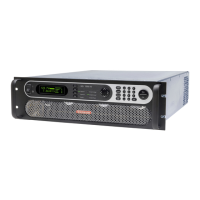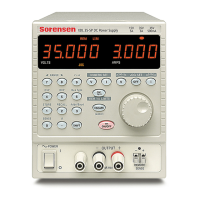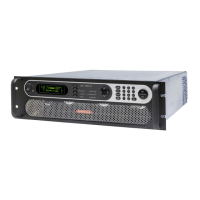SCPI Command Operation SG Series Programming
6-48 M550129-03 Rev L
(Notice in this example the sequence is being ended with a RETURN rather than a STOP.
A RETURN is more flexible because it automatically acts like a stop when SEQ2 is run
directly; and yet, if SEQ2 is run as a sub-sequence, then the RETURN shall act as a
statement to return to the calling sequence.)
To run SEQ2 directly, issue the command as before:
OUTP:STAT ON
PROG:STAT RUN
For the running sequence, the power supply output for Example 2 should look like the
following:
Figure 6-2. Power Supply Output for Example 2
Once the ramp goes down to 2 volts, the sequence stops and the unit remains at the state
of the last command within the sequence.
EXAMPLE 3
Issue *RST to establish a known state.
In this third example, redefine SEQ1 so that it calls SEQ2 as a
subroutine.
To modify SEQ1 requires that it be deleted, and re-written. Overwriting a completed,
existing sequence is not allowed by the SCPI command interface for code readability
reasons. Even though overwriting is not permitted, re-writing is permitted after a sequence
has been deleted. Delete the SEQ1 sequence as follows:
PROG:NAME “SEQ1”
PROG:DEL:SEL
That deletes SEQ1.
Now create a new SEQ1 that calls SEQ2 as a subsequence.
PROG:NAME “SEQ1”
PROG:MALL DEFAULT
PROG:DEF 1, VIMODE, 3, 4, 11, 10 //go to 3 volts, 4 amps, 11 volts ovp, for 10 sec
Ramp down to 2
volts in 9 sec
Notice that after the RETURN
statement is encountered in this run
of SEQ2, since SEQ2 is being used
as a primary sequence, the RETURN
acts like a STOP statement and stops
running the sequence.

